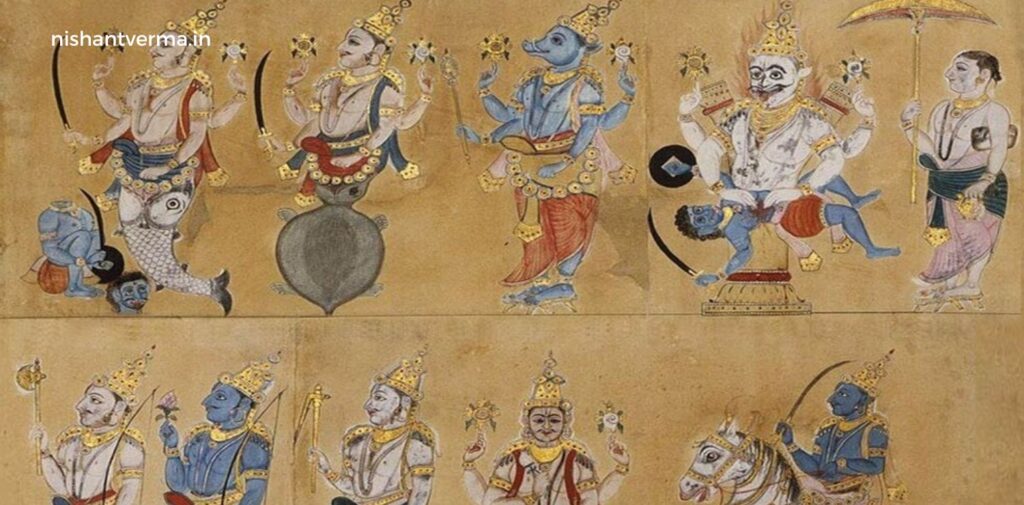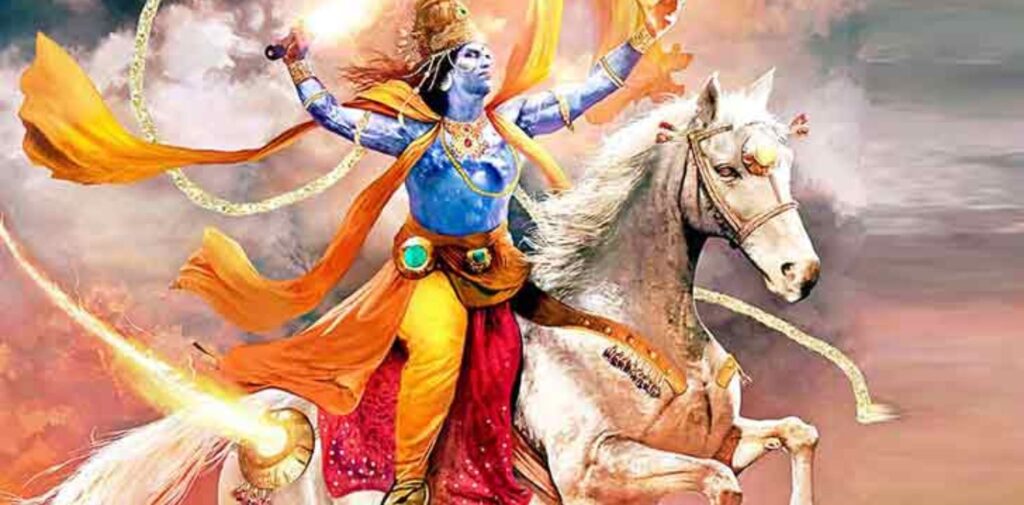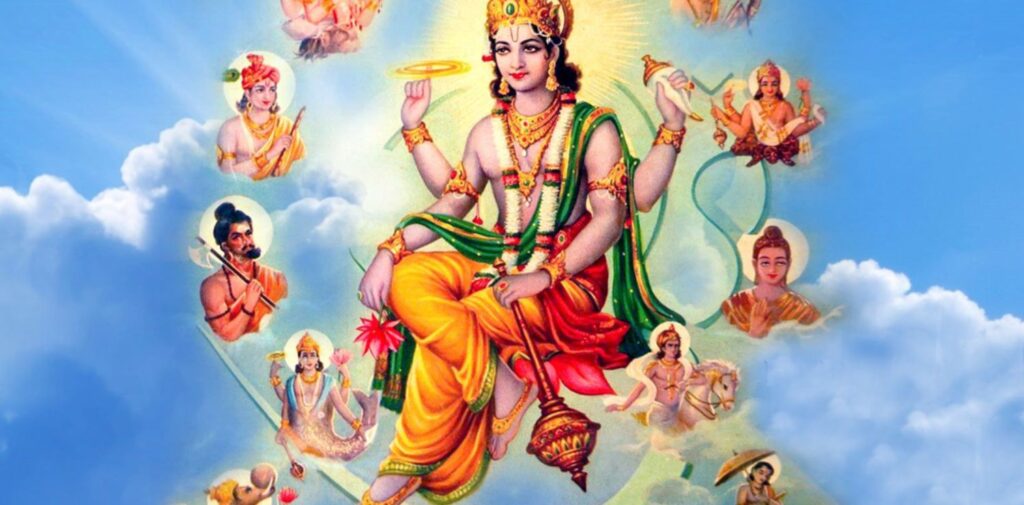In the rich and colorful tapestry of Ancient Indian mythology, the concept of Vishnu’s Avatars holds a central place. Vishnu, one of the principal deities of Hinduism, is often referred to as the preserver and protector of the universe. While other deities like Brahma (the creator) and Shiva (the destroyer) play their vital roles in the cosmic cycle, Vishnu is believed to maintain order and harmony in the world.
One of the most fascinating aspects of Vishnu’s role is his ability to take on different forms, known as Avatars. The word “Avatar” is derived from the Sanskrit root “ava” meaning “down” and “tar” meaning “to cross” or “to descend.” In simple terms, Avatar means a divine being descending to Earth in a physical form. According to Hindu mythology, Vishnu incarnates in various forms whenever the Earth is threatened by evil or chaos, to restore balance and protect righteousness.
This article explores the concept of Vishnu’s avatars, their significance, and how these divine incarnations serve the ultimate purpose of protecting Dharma (cosmic law) and defeating Adharma (evil).

The Ten Avatars of Vishnu (Dashavatara)
The most well-known and widely accepted avatars of Vishnu are the Dashavatara, which literally means “ten incarnations.” These ten avatars represent various forms in which Vishnu has descended to Earth to restore cosmic order. Each avatar has a unique story and symbolism associated with it, addressing specific issues faced by the world at different points in time. The ten avatars are:
- Matsya (The Fish): The first avatar of Vishnu, Matsya, appeared as a fish. According to the story, a great flood submerged the Earth, and the ancient scriptures were at risk of being lost. Vishnu took the form of a giant fish to save the scriptures and guide the sage Manu’s boat to safety, carrying a pair of every living species to ensure the preservation of life. This avatar symbolizes the preservation of knowledge and life.
- Kurma (The Tortoise): In the second avatar, Vishnu incarnated as a tortoise, Kurma, to aid the gods in the churning of the ocean of milk. The gods and demons had been churning the ocean to obtain the nectar of immortality (amrita), but they needed a stable foundation to do so. Vishnu took the form of a tortoise and supported Mount Mandara, which was being used as the churning rod, on his back. This avatar represents the support of stability and harmony in times of difficulty.
- Varaha (The Boar): The third avatar of Vishnu, Varaha, took the form of a giant boar to rescue the Earth, which had been submerged in the cosmic ocean by the demon Hiranyaksha. Vishnu, in his boar form, dived into the ocean and lifted the Earth out of the water with his tusks, restoring balance and protecting the planet from destruction. The Varaha avatar symbolizes the victory of good over evil and the protection of the Earth.
- Narasimha (The Man-Lion): The fourth avatar, Narasimha, was a half-man, half-lion figure. This form of Vishnu appeared to protect his devotee Prahlada, a young prince who was a devoted follower of Vishnu. Prahlada’s father, Hiranyakashipu, was a powerful demon king who could not be killed by man or beast, during day or night. Vishnu took the form of Narasimha to slay Hiranyakashipu, proving that the divine can always overcome evil. This avatar symbolizes divine justice and protection.
- Vamana (The Dwarf): Vamana, the fifth avatar of Vishnu, appeared as a dwarf Brahmin. He visited the demon king Bali, who had gained control over the heavens, Earth, and the underworld. Bali agreed to give Vamana three paces of land, but Vamana, in his divine form, grew in size and covered the entire universe in three steps, restoring the balance of power between the gods and demons. This avatar teaches humility and the importance of wisdom over physical power.
- Parashurama (The Warrior with an Axe): In the sixth avatar, Parashurama was born as a Brahmin warrior with an axe. He is known for his role in eliminating the corrupt Kshatriya rulers who had misused their power. Parashurama’s story reflects the principle of justice, and his actions were driven by the desire to rid the world of tyranny and bring order. His avatar emphasizes the importance of upholding righteousness, even in the face of overwhelming adversity.
- Rama (The Prince of Ayodhya): The seventh avatar, Rama, is perhaps one of the most famous and revered avatars of Vishnu. He is the hero of the ancient Indian epic, the Ramayana. Rama’s story is one of righteousness, sacrifice, and devotion. He was born as the prince of Ayodhya and was exiled to the forest, where his wife Sita was abducted by the demon king Ravana. Rama’s quest to rescue Sita and restore dharma is a powerful tale of devotion, courage, and justice. The Rama avatar teaches the values of loyalty, honor, and the victory of good over evil.
- Krishna (The Divine Cowherd): The eighth avatar of Vishnu, Krishna, is perhaps the most celebrated figure in Hindu mythology. Krishna’s life and teachings are documented in the Mahabharata, particularly in the Bhagavad Gita, where he serves as a charioteer and guide to the Pandava prince Arjuna during the Kurukshetra War. Krishna’s teachings on dharma, duty, and devotion have had a lasting impact on Hindu philosophy. His playful and mischievous childhood exploits, his role as a lover, and his wisdom as a statesman make him a multifaceted figure. The Krishna avatar highlights divine love, the importance of righteous action, and the power of devotion.
- Buddha (The Enlightened One): The ninth avatar, Buddha, is believed by many to be an incarnation of Vishnu, though this is a later addition to the Dashavatara list. Buddha’s teachings on suffering, detachment, and the path to enlightenment significantly influenced millions of followers worldwide. Vishnu’s incarnation as the Buddha in this avatar reflects the idea of spiritual wisdom and the evolution of religious thought in ancient India. This avatar emphasizes the importance of inner peace, self-realization, and the removal of ignorance.
- Kalki (The Future Savior): The tenth and final avatar, Kalki, is yet to appear. According to prophecy, Kalki will be born in the future as a warrior on a white horse, bringing an end to the current age of darkness and corruption, known as Kali Yuga. He will restore righteousness and destroy the forces of evil, ushering in a new era of truth and virtue. The Kalki avatar signifies hope, renewal, and the eventual triumph of good over evil.

Significance of Vishnu’s Avatars
The concept of Vishnu’s avatars is not just a mythological tale; it holds profound symbolic meanings. Each avatar represents a response to a specific problem in the universe. Vishnu’s incarnations show that the divine will intervene when the world is in danger, and when evil or chaos threatens the balance of existence. These avatars illustrate the various ways in which divine intervention can manifest—sometimes through wisdom, other times through strength, and at times through kindness.
Each avatar of Vishnu addresses different aspects of human experience: protection, justice, love, wisdom, and sacrifice. The avatars serve as reminders of the divine order, and they teach people how to live righteous lives, respect cosmic laws, and uphold dharma.

Conclusion – Vishnu’s Avatars in Ancient Indian Mythology
The concept of Vishnu’s avatars is a fundamental part of Ancient Indian mythology and has inspired countless generations. From the humble fish Matsya to the future savior Kalki, Vishnu’s ten avatars showcase a journey of divine intervention that restores balance in the universe. Each avatar represents a different aspect of the divine, offering insights into the ways in which the divine interacts with the world and the role humans must play in maintaining harmony and righteousness. These stories continue to inspire and guide people, offering timeless lessons on the nature of good, evil, and the eternal struggle to uphold cosmic order.



